Developmental indicators: India
(→2011> 2018) |
(→2011 vis-à-vis 2021) |
||
| (5 intermediate revisions by one user not shown) | |||
| Line 1: | Line 1: | ||
| − | [[ | + | =1947 vis-à-vis 2020= |
| − | [[Category:Development| | + | [[File: Income per person and population density- India’s developmental indicators- 1947 vis-à-vis 2020.jpg|Income per person and population density- India’s developmental indicators- 1947 vis-à-vis 2020 <br/> From: [https://timesofindia.indiatimes.com/india/1947-2020-how-far-have-we-come/articleshow/77551568.cms August 15, 2020: ''The Times of India'']|frame|500px]] |
| + | |||
| + | [[File: No. of kids per woman, largest city- India’s developmental indicators- 1947 vis-à-vis 2020.jpg|No. of kids per woman, largest city- India’s developmental indicators- 1947 vis-à-vis 2020 <br/> From: [https://timesofindia.indiatimes.com/india/1947-2020-how-far-have-we-come/articleshow/77551568.cms August 15, 2020: ''The Times of India'']|frame|500px]] | ||
| + | |||
| + | [[File: How long Indians live, urban population- India’s developmental indicators- 1947 vis-à-vis 2020.jpg|How long Indians live, urban population- India’s developmental indicators- 1947 vis-à-vis 2020 <br/> From: [https://timesofindia.indiatimes.com/india/1947-2020-how-far-have-we-come/articleshow/77551568.cms August 15, 2020: ''The Times of India'']|frame|500px]] | ||
| + | |||
| + | [[File: Car ownership, electricity usage- India’s developmental indicators- 1947 vis-à-vis 2020.jpg|Car ownership, electricity usage- India’s developmental indicators- 1947 vis-à-vis 2020 <br/> From: [https://timesofindia.indiatimes.com/india/1947-2020-how-far-have-we-come/articleshow/77551568.cms Sajeev Kumarapuram, August 15, 2020: ''The Times of India'']|frame|500px]] | ||
| + | |||
| + | [[File: Crime, biggest bollywood hit- India’s developmental indicators- 1947 vis-à-vis 2020.jpg|Crime, biggest bollywood hit- India’s developmental indicators- 1947 vis-à-vis 2020 <br/> From: [https://timesofindia.indiatimes.com/india/1947-2020-how-far-have-we-come/articleshow/77551568.cms Sajeev Kumarapuram, August 15, 2020: ''The Times of India'']|frame|500px]] | ||
| + | |||
| + | [[File: Political map of India- on the eve of independence and today- India’s developmental indicators- 1947 vis-à-vis 2020.jpg|Political map of India- on the eve of independence and today- India’s developmental indicators- 1947 vis-à-vis 2020 <br/> From: [https://timesofindia.indiatimes.com/india/1947-2020-how-far-have-we-come/articleshow/77551568.cms August 15, 2020: ''The Times of India'']|frame|500px]] | ||
| + | |||
| + | [[File: Pakistan on two sides of India, Pakistan on only one side of India- India’s developmental indicators- 1947 vis-à-vis 2020.jpg|Pakistan on two sides of India, Pakistan on only one side of India- India’s developmental indicators- 1947 vis-à-vis 2020 <br/> From: [https://timesofindia.indiatimes.com/india/1947-2020-how-far-have-we-come/articleshow/77551568.cms August 15, 2020: ''The Times of India'']|frame|500px]] | ||
| + | |||
| + | |||
| + | '''See graphics''': | ||
| + | |||
| + | ''Income per person and population density- India’s developmental indicators- 1947 vis-à-vis 2020'' | ||
| + | |||
| + | ''No. of kids per woman, largest city- India’s developmental indicators- 1947 vis-à-vis 2020'' | ||
| + | |||
| + | ''How long Indians live, urban population- India’s developmental indicators- 1947 vis-à-vis 2020'' | ||
| + | |||
| + | ''Car ownership, electricity usage- India’s developmental indicators- 1947 vis-à-vis 2020'' | ||
| + | |||
| + | ''Crime, biggest bollywood hit- India’s developmental indicators- 1947 vis-à-vis 2020'' | ||
| + | |||
| + | ''Political map of India- on the eve of independence and today- India’s developmental indicators- 1947 vis-à-vis 2020'' | ||
| + | |||
| + | ''Pakistan on two sides of India, Pakistan on only one side of India- India’s developmental indicators- 1947 vis-à-vis 2020'' | ||
| + | |||
| + | |||
| + | ==1947 vis-à-vis 2021== | ||
| + | [[File: India’s Developmental indicators- 1947 vis-à-vis 2021.jpg| India’s Developmental indicators: 1947 vis-à-vis 2021 <br/> From: [https://epaper.timesgroup.com/Olive/ODN/TimesOfIndia/shared/ShowArticle.aspx?doc=TOIM/2021/08/15&entity=Ar00703&sk=4935BBCF&mode=image August 15, 2021: ''The Times of India'']|frame|500px]] | ||
| + | |||
| + | '''See graphic''': | ||
| + | |||
| + | '' India’s Developmental indicators: 1947 vis-à-vis 2021 '' | ||
| + | |||
| + | [[Category:Development|DDEVELOPMENTAL INDICATORS: INDIADEVELOPMENTAL INDICATORS: INDIA | ||
| + | DEVELOPMENTAL INDICATORS: INDIA]] | ||
| + | [[Category:India|DDEVELOPMENTAL INDICATORS: INDIADEVELOPMENTAL INDICATORS: INDIA | ||
| + | DEVELOPMENTAL INDICATORS: INDIA]] | ||
| + | [[Category:Pages with broken file links|DEVELOPMENTAL INDICATORS: INDIA | ||
| + | DEVELOPMENTAL INDICATORS: INDIA]] | ||
=!984-2014= | =!984-2014= | ||
| Line 30: | Line 74: | ||
''Urban and rural India ‘s developmental indicators, 2011> 2018 in terms of access to<br/> Electricity, <br/> Tap water, <br/> Toilets at home, <br/> LPG connections.'' | ''Urban and rural India ‘s developmental indicators, 2011> 2018 in terms of access to<br/> Electricity, <br/> Tap water, <br/> Toilets at home, <br/> LPG connections.'' | ||
| − | = | + | =2014, 2015= |
| − | [https://epaper.timesgroup.com/Olive/ODN/TimesOfIndia/shared/ShowArticle.aspx?doc=TOIDEL% | + | [[File: Status of sustainable development in India- 2014, 2015.jpg|Status of sustainable development in India: 2014, 2015 <br/> From: [https://epaper.timesgroup.com/Olive/ODN/TimesOfIndia/shared/ShowArticle.aspx?doc=TOIDEL%2F2019%2F01%2F19&entity=Ar00800&sk=16EA670F&mode=image January 19, 2019: ''The Times of India'']|frame|500px]] |
| + | |||
| + | '''See graphic''': | ||
| + | |||
| + | ''Status of sustainable development in India: 2014, 2015'' | ||
| + | |||
| + | |||
| + | =2011 vis-à-vis 2021= | ||
| + | [https://timesofindia.indiatimes.com/india/12-then-now-maps-to-show-indias-progress/articleshow/89255963.cms Source: The Economic Survey of India: February 1, 2022: ''The Times of India''] | ||
| + | |||
| + | [[File: Night-time luminosity, 2012-21.jpg|Night-time luminosity, 2012-21 <br/> From: [https://timesofindia.indiatimes.com/india/12-then-now-maps-to-show-indias-progress/articleshow/89255963.cms Source: The Economic Survey of India: February 1, 2022: ''The Times of India'']|frame|500px]] | ||
| + | |||
| + | [[File: Highway network, 2012-21.jpg|Highway network, 2012-21 <br/> From: [https://timesofindia.indiatimes.com/india/12-then-now-maps-to-show-indias-progress/articleshow/89255963.cms Source: The Economic Survey of India: February 1, 2022: ''The Times of India'']|frame|500px]] | ||
| + | |||
| + | [[File: Delhi metro rail, 2011-21.jpg|Delhi metro rail, 2011-21 <br/> From:[https://timesofindia.indiatimes.com/india/12-then-now-maps-to-show-indias-progress/articleshow/89255963.cms Source: The Economic Survey of India: February 1, 2022: ''The Times of India''] |frame|500px]] | ||
| + | |||
| + | [[File: Bengaluru metro rail network, 2022-21.jpg|Bengaluru metro rail network, 2022-21 <br/> From: [https://timesofindia.indiatimes.com/india/12-then-now-maps-to-show-indias-progress/articleshow/89255963.cms Source: The Economic Survey of India: February 1, 2022: ''The Times of India'']|frame|500px]] | ||
| + | |||
| + | [[File: Kolkata metro rail network, 2011-21.jpg|Kolkata metro rail network, 2011-21 <br/> From: [https://timesofindia.indiatimes.com/india/12-then-now-maps-to-show-indias-progress/articleshow/89255963.cms Source: The Economic Survey of India: February 1, 2022: ''The Times of India'']|frame|500px]] | ||
| + | |||
| + | [[File: Metro rail network across cities, 2021.jpg|Metro rail network across cities, 2021 <br/> From: [https://timesofindia.indiatimes.com/india/12-then-now-maps-to-show-indias-progress/articleshow/89255963.cms Source: The Economic Survey of India: February 1, 2022: ''The Times of India'']|frame|500px]] | ||
| + | |||
| + | [[File: Operationalised airports, 2016-21.jpg|Operationalised airports, 2016-21 <br/> From: [https://timesofindia.indiatimes.com/india/12-then-now-maps-to-show-indias-progress/articleshow/89255963.cms Source: The Economic Survey of India: February 1, 2022: ''The Times of India'']|frame|500px]] | ||
| + | |||
| + | [[File: Commercial bank branches, 2011- 21.jpg|Commercial bank branches, 2011- 21 <br/> From: [https://timesofindia.indiatimes.com/india/12-then-now-maps-to-show-indias-progress/articleshow/89255963.cms Source: The Economic Survey of India: February 1, 2022: ''The Times of India'']|frame|500px]] | ||
| + | |||
| + | [[File: Population density in Delhi-NCR, 2001-21.jpg|Population density in Delhi-NCR, 2001-21 <br/> From: [https://timesofindia.indiatimes.com/india/12-then-now-maps-to-show-indias-progress/articleshow/89255963.cms Source: The Economic Survey of India: February 1, 2022: ''The Times of India'']|frame|500px]] | ||
| + | |||
| + | [[File: Population density in Greater Bengaluru, 2001-21.jpg|Population density in Greater Bengaluru, 2001-21 <br/> From: [https://timesofindia.indiatimes.com/india/12-then-now-maps-to-show-indias-progress/articleshow/89255963.cms Source: The Economic Survey of India: February 1, 2022: ''The Times of India'']|frame|500px]] | ||
| + | |||
| + | [[File: Net sown area, 2005-06- 2020-21.jpg|Net sown area, 2005-06- 2020-21 <br/> From: [https://timesofindia.indiatimes.com/india/12-then-now-maps-to-show-indias-progress/articleshow/89255963.cms Source: The Economic Survey of India: February 1, 2022: ''The Times of India'']|frame|500px]] | ||
| + | |||
| + | [[File: Agricultural activity at the Omkareshwar reservoir, Madhya Pradesh, 2000-19.jpg|Agricultural activity at the Omkareshwar reservoir, Madhya Pradesh, 2000-19 <br/> From: [https://timesofindia.indiatimes.com/india/12-then-now-maps-to-show-indias-progress/articleshow/89255963.cms Source: The Economic Survey of India: February 1, 2022: ''The Times of India'']|frame|500px]] | ||
| + | |||
| + | [[File: Annual cycle of water storage at Stanley reservoir, Tamil Nadu, 2016-17- 2020-21.jpg|Annual cycle of water storage at Stanley reservoir, Tamil Nadu, 2016-17- 2020-21 <br/> From: [https://timesofindia.indiatimes.com/india/12-then-now-maps-to-show-indias-progress/articleshow/89255963.cms Source: The Economic Survey of India: February 1, 2022: ''The Times of India'']|frame|500px]] | ||
| + | |||
| + | [[File: Kharif crop cycle in Moga, Punjab, 2005-21.jpg|Kharif crop cycle in Moga, Punjab, 2005-21 <br/> From: [https://timesofindia.indiatimes.com/india/12-then-now-maps-to-show-indias-progress/articleshow/89255963.cms Source: The Economic Survey of India: February 1, 2022: ''The Times of India'']|frame|500px]] | ||
| + | |||
| + | |||
| + | How does the picture of India’s economic progress change when we move from a worm’s eye view to a bird’s eye view? A chapter in this year’s economic survey attempts to show the change by moving away from economic data to another kind of data – geospatial data and cartographic techniques. | ||
| + | |||
| + | Using these tools the Survey tracked, compared, and illustrated long-term developments in the economy that get ignored in day-to-day news and analysis. For example, can nightlights captured through satellites show how greater access to electricity has changed India? Or can a 15-year visual comparison of sowing cycles in Punjab help us understand why farmers are now burning stubble more than ever? | ||
| + | |||
| + | |||
| + | ''' ''Here are 12 images of India’s economic progress you may not have seen before: '' ''' | ||
| + | |||
| + | |||
| + | '''The night sky is brighter''' | ||
| + | |||
| + | India’s night-time luminosity in 2012 and 2021 shows the expansion of electricity supply and economic activity. | ||
| + | |||
| + | |||
| + | '''Roads of development are longer ''' | ||
| + | |||
| + | India's national highway length has almost doubled between 2011 and 2021. | ||
| + | |||
| + | |||
| + | '''City commutes are faster and better ''' | ||
| + | |||
| + | The expansion of existing metro rail networks in cities like Kolkata, Delhi and Bengaluru and new ones in smaller ones like Lucknow, Kanpur and Kochi has made daily commute more convenient in several cities. | ||
| + | |||
| + | |||
| + | '''More places to fly to and from''' | ||
| + | |||
| + | Within a span of just five years, the number of airports has more than doubled. | ||
| + | |||
| + | |||
| + | '''A bank on every street''' | ||
| + | |||
| + | The expansion of commercial banking to every nook and corner of the country is an indication of the increase in economic activity. | ||
| + | |||
| + | |||
| + | '''India's moving to the cities …''' | ||
| + | |||
| + | As cities get crowded, they have also expanded bringing a much bigger area into their fold. | ||
| + | |||
| + | |||
| + | '''… and changing the urban landscape''' | ||
| + | |||
| + | The needs of a growing urban population is changing the face of our cities too. | ||
| + | |||
| + | |||
| + | '''We are growing more food…''' | ||
| + | |||
| + | The net sown area has increased by a fifth in the past 15 years. | ||
| + | |||
| + | |||
| + | '''… as irrigation network expands''' | ||
| + | |||
| + | '''… and we learn to use water better''' | ||
| + | |||
| + | '''We have created problems…''' | ||
| + | |||
| + | The Kharif crop cycle in Punjab's Moga district has shifted ahead by two-to-three weeks between 2005 and 2021 causing the Kharif harvest to almost coincide with Rabi sowing in November. This has encouraged farmers to burn stubble. This is also related to the restrictions on early transplanting of Kharif paddy put in place in 2009 in order to reduce pumping of groundwater. However, that had the unintended consequence of damaging air quality. | ||
| + | |||
| − | + | '''…. but are also making amends''' | |
| − | + | The wasteland redeployment for industrial use in Nellore, Andhra Pradesh, and for generation of solar power in Charanka, Gujarat, show that a change for better is possible. | |
| − | '' | + | =2019= |
| + | [https://epaper.timesgroup.com/Olive/ODN/TimesOfIndia/shared/ShowArticle.aspx?doc=TOIDEL%2F2019%2F12%2F31&entity=Ar01104&sk=5DCE96E5&mode=text Ambika Pandit, Dec 31, 2019: ''The Times of India''] | ||
| − | + | [[File: The Sustainable Development Goals India Index 2019- the best and worst states.jpg|The Sustainable Development Goals India Index 2019: the best and worst states. <br/> From: [https://epaper.timesgroup.com/Olive/ODN/TimesOfIndia/shared/ShowArticle.aspx?doc=TOIDEL%2F2019%2F12%2F31&entity=Ar01104&sk=5DCE96E5&mode=text Ambika Pandit, Dec 31, 2019: ''The Times of India''] |frame|500px]] | |
| − | + | India improved its overall score by three points over last year from 57 to 60 as per the Sustainable Development Goals India Index 2019, based on progress made by states and Union Territories so far towards achieving the 2030 SDG targets. | |
| − | Kerala and | + | Kerala claimed the top slot like last year among states. The state shares the “front runners” category with seven other states and two UTs Chandigarh and Puducherry. Bihar found itself at the bottom of the list of “27 performer states”. In the second edition of SDG India Index released by NITI Aayog on progress across 16 SDGs, India for now finds itself in the “performers” category, which has a score range of 50 to 64, as its delivery on goals is a mixed bag of good news and serious concerns. The assessment is based on progress of states and UTs on 100 indicators drawn from the National Indicator Framework prepared by the ministry of statistics and programme implementation. |
| − | Among | + | Among UTs, Chandigarh kept the top slot like last year with a score of 70. While no state could get close enough to the “achiever” tag with a full score of 100, the scorecard points out that this year no state falls in the lowest category of “aspirants” with a score range of 0-49 score. Last year Bihar, Uttar Pradesh and Assam figured in this category. |
| − | + | Only three states — Himachal Pradesh, Kerala and Tamil Nadu — were placed in the category of front runners in 2018. In 2019, five more states joined this league – Andhra Pradesh, Telangana, Karnataka, Sikkim and Goa. | |
| − | The | + | The report attributes the “positive push” reflecting improvement in performance of states to essentially five goals — clean water and sanitation, affordable and clean energy, industry, innovation and infrastructure, life on land and peace, justice and strong institutions. |
| − | + | [[Category:Development|DDEVELOPMENTAL INDICATORS: INDIADEVELOPMENTAL INDICATORS: INDIADEVELOPMENTAL INDICATORS: INDIA | |
| + | DEVELOPMENTAL INDICATORS: INDIA]] | ||
| + | [[Category:India|DDEVELOPMENTAL INDICATORS: INDIADEVELOPMENTAL INDICATORS: INDIADEVELOPMENTAL INDICATORS: INDIA | ||
| + | DEVELOPMENTAL INDICATORS: INDIA]] | ||
| + | [[Category:Pages with broken file links|DEVELOPMENTAL INDICATORS: INDIADEVELOPMENTAL INDICATORS: INDIA | ||
| + | DEVELOPMENTAL INDICATORS: INDIA]] | ||
Latest revision as of 22:18, 28 February 2022
Contents |
[edit] 1947 vis-à-vis 2020

From: August 15, 2020: The Times of India
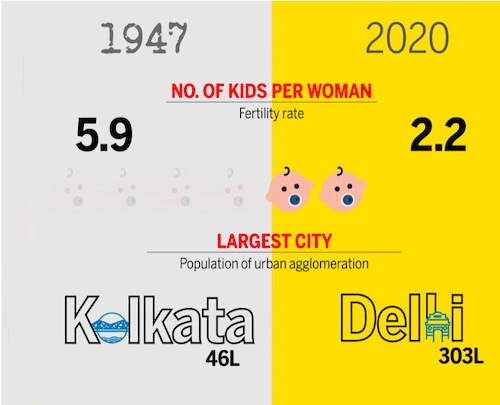
From: August 15, 2020: The Times of India

From: August 15, 2020: The Times of India
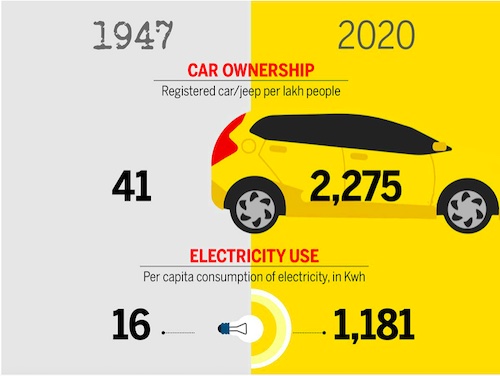
From: Sajeev Kumarapuram, August 15, 2020: The Times of India
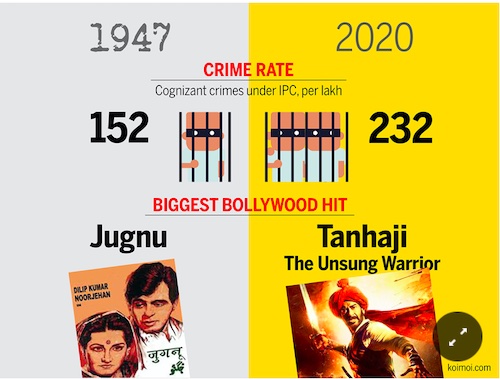
From: Sajeev Kumarapuram, August 15, 2020: The Times of India

From: August 15, 2020: The Times of India

From: August 15, 2020: The Times of India
See graphics:
Income per person and population density- India’s developmental indicators- 1947 vis-à-vis 2020
No. of kids per woman, largest city- India’s developmental indicators- 1947 vis-à-vis 2020
How long Indians live, urban population- India’s developmental indicators- 1947 vis-à-vis 2020
Car ownership, electricity usage- India’s developmental indicators- 1947 vis-à-vis 2020
Crime, biggest bollywood hit- India’s developmental indicators- 1947 vis-à-vis 2020
Political map of India- on the eve of independence and today- India’s developmental indicators- 1947 vis-à-vis 2020
Pakistan on two sides of India, Pakistan on only one side of India- India’s developmental indicators- 1947 vis-à-vis 2020
[edit] 1947 vis-à-vis 2021
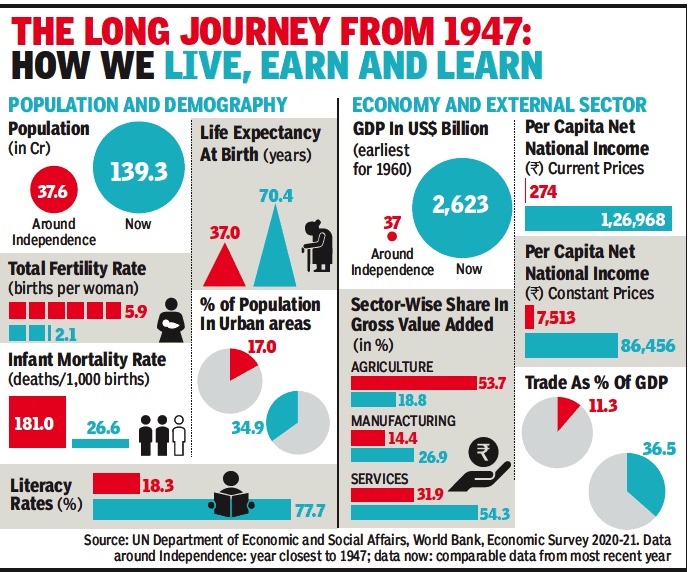
From: August 15, 2021: The Times of India
See graphic:
India’s Developmental indicators: 1947 vis-à-vis 2021
[edit] !984-2014
[edit] Education

See Graphic ‘Education in India: 1984-2014
[edit] Income

See Graphic ‘Per capita income in India: 1984-2014
[edit] Infant morality
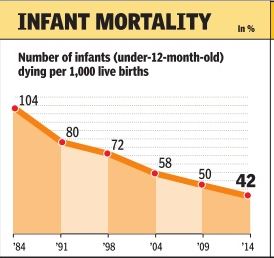
See Graphic ‘Infant Mortality in India: 1984-2014
[edit] Poverty

See Graphic ‘Poverty in India: 1984-2014
[edit] Unemployment

See Graphic ‘Unemployment in India: 1984-2014
[edit] 2011> 2018

Electricity,
Tap water,
Toilets at home,
LPG connections.
From: October 5, 2018: The Times of India
See graphic:
Urban and rural India ‘s developmental indicators, 2011> 2018 in terms of access to
Electricity,
Tap water,
Toilets at home,
LPG connections.
[edit] 2014, 2015

From: January 19, 2019: The Times of India
See graphic:
Status of sustainable development in India: 2014, 2015
[edit] 2011 vis-à-vis 2021
Source: The Economic Survey of India: February 1, 2022: The Times of India

From: Source: The Economic Survey of India: February 1, 2022: The Times of India
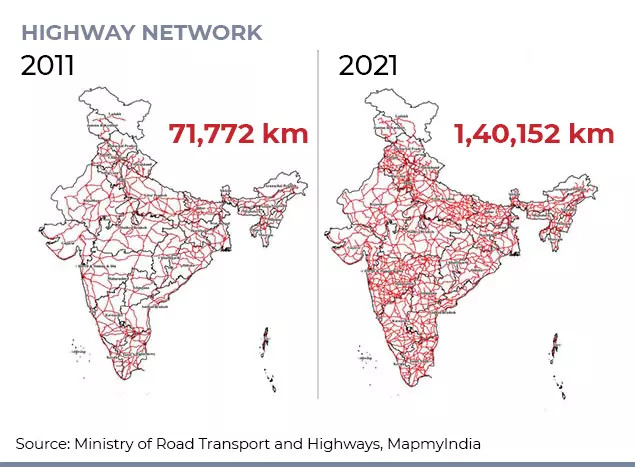
From: Source: The Economic Survey of India: February 1, 2022: The Times of India
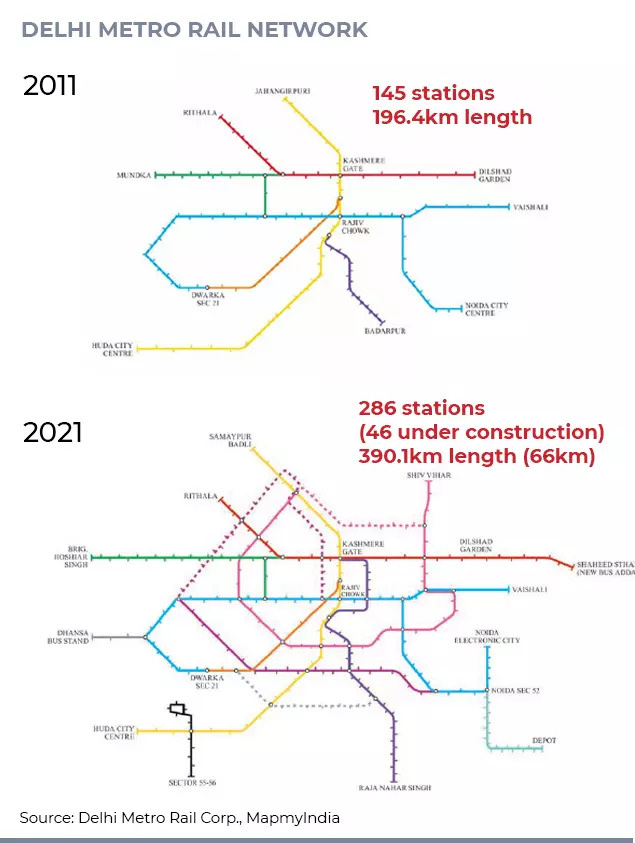
From:Source: The Economic Survey of India: February 1, 2022: The Times of India

From: Source: The Economic Survey of India: February 1, 2022: The Times of India

From: Source: The Economic Survey of India: February 1, 2022: The Times of India

From: Source: The Economic Survey of India: February 1, 2022: The Times of India

From: Source: The Economic Survey of India: February 1, 2022: The Times of India

From: Source: The Economic Survey of India: February 1, 2022: The Times of India

From: Source: The Economic Survey of India: February 1, 2022: The Times of India

From: Source: The Economic Survey of India: February 1, 2022: The Times of India

From: Source: The Economic Survey of India: February 1, 2022: The Times of India
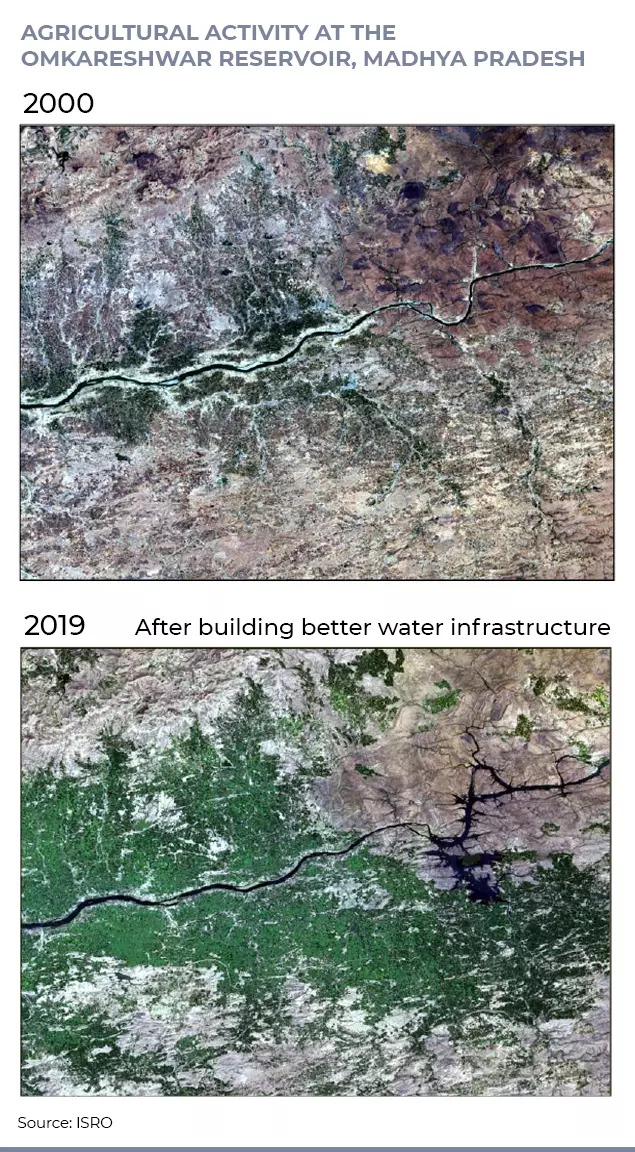
From: Source: The Economic Survey of India: February 1, 2022: The Times of India

From: Source: The Economic Survey of India: February 1, 2022: The Times of India
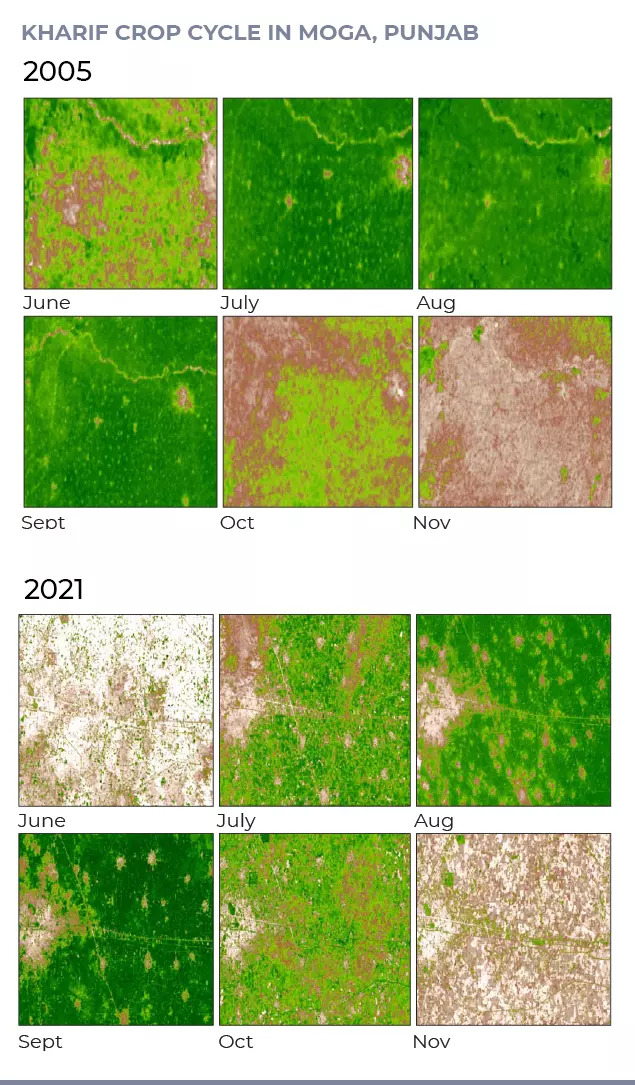
From: Source: The Economic Survey of India: February 1, 2022: The Times of India
How does the picture of India’s economic progress change when we move from a worm’s eye view to a bird’s eye view? A chapter in this year’s economic survey attempts to show the change by moving away from economic data to another kind of data – geospatial data and cartographic techniques.
Using these tools the Survey tracked, compared, and illustrated long-term developments in the economy that get ignored in day-to-day news and analysis. For example, can nightlights captured through satellites show how greater access to electricity has changed India? Or can a 15-year visual comparison of sowing cycles in Punjab help us understand why farmers are now burning stubble more than ever?
Here are 12 images of India’s economic progress you may not have seen before:
The night sky is brighter
India’s night-time luminosity in 2012 and 2021 shows the expansion of electricity supply and economic activity.
Roads of development are longer
India's national highway length has almost doubled between 2011 and 2021.
City commutes are faster and better
The expansion of existing metro rail networks in cities like Kolkata, Delhi and Bengaluru and new ones in smaller ones like Lucknow, Kanpur and Kochi has made daily commute more convenient in several cities.
More places to fly to and from
Within a span of just five years, the number of airports has more than doubled.
A bank on every street
The expansion of commercial banking to every nook and corner of the country is an indication of the increase in economic activity.
India's moving to the cities …
As cities get crowded, they have also expanded bringing a much bigger area into their fold.
… and changing the urban landscape
The needs of a growing urban population is changing the face of our cities too.
We are growing more food…
The net sown area has increased by a fifth in the past 15 years.
… as irrigation network expands
… and we learn to use water better
We have created problems…
The Kharif crop cycle in Punjab's Moga district has shifted ahead by two-to-three weeks between 2005 and 2021 causing the Kharif harvest to almost coincide with Rabi sowing in November. This has encouraged farmers to burn stubble. This is also related to the restrictions on early transplanting of Kharif paddy put in place in 2009 in order to reduce pumping of groundwater. However, that had the unintended consequence of damaging air quality.
…. but are also making amends
The wasteland redeployment for industrial use in Nellore, Andhra Pradesh, and for generation of solar power in Charanka, Gujarat, show that a change for better is possible.
[edit] 2019
Ambika Pandit, Dec 31, 2019: The Times of India

From: Ambika Pandit, Dec 31, 2019: The Times of India
India improved its overall score by three points over last year from 57 to 60 as per the Sustainable Development Goals India Index 2019, based on progress made by states and Union Territories so far towards achieving the 2030 SDG targets.
Kerala claimed the top slot like last year among states. The state shares the “front runners” category with seven other states and two UTs Chandigarh and Puducherry. Bihar found itself at the bottom of the list of “27 performer states”. In the second edition of SDG India Index released by NITI Aayog on progress across 16 SDGs, India for now finds itself in the “performers” category, which has a score range of 50 to 64, as its delivery on goals is a mixed bag of good news and serious concerns. The assessment is based on progress of states and UTs on 100 indicators drawn from the National Indicator Framework prepared by the ministry of statistics and programme implementation.
Among UTs, Chandigarh kept the top slot like last year with a score of 70. While no state could get close enough to the “achiever” tag with a full score of 100, the scorecard points out that this year no state falls in the lowest category of “aspirants” with a score range of 0-49 score. Last year Bihar, Uttar Pradesh and Assam figured in this category.
Only three states — Himachal Pradesh, Kerala and Tamil Nadu — were placed in the category of front runners in 2018. In 2019, five more states joined this league – Andhra Pradesh, Telangana, Karnataka, Sikkim and Goa.
The report attributes the “positive push” reflecting improvement in performance of states to essentially five goals — clean water and sanitation, affordable and clean energy, industry, innovation and infrastructure, life on land and peace, justice and strong institutions.